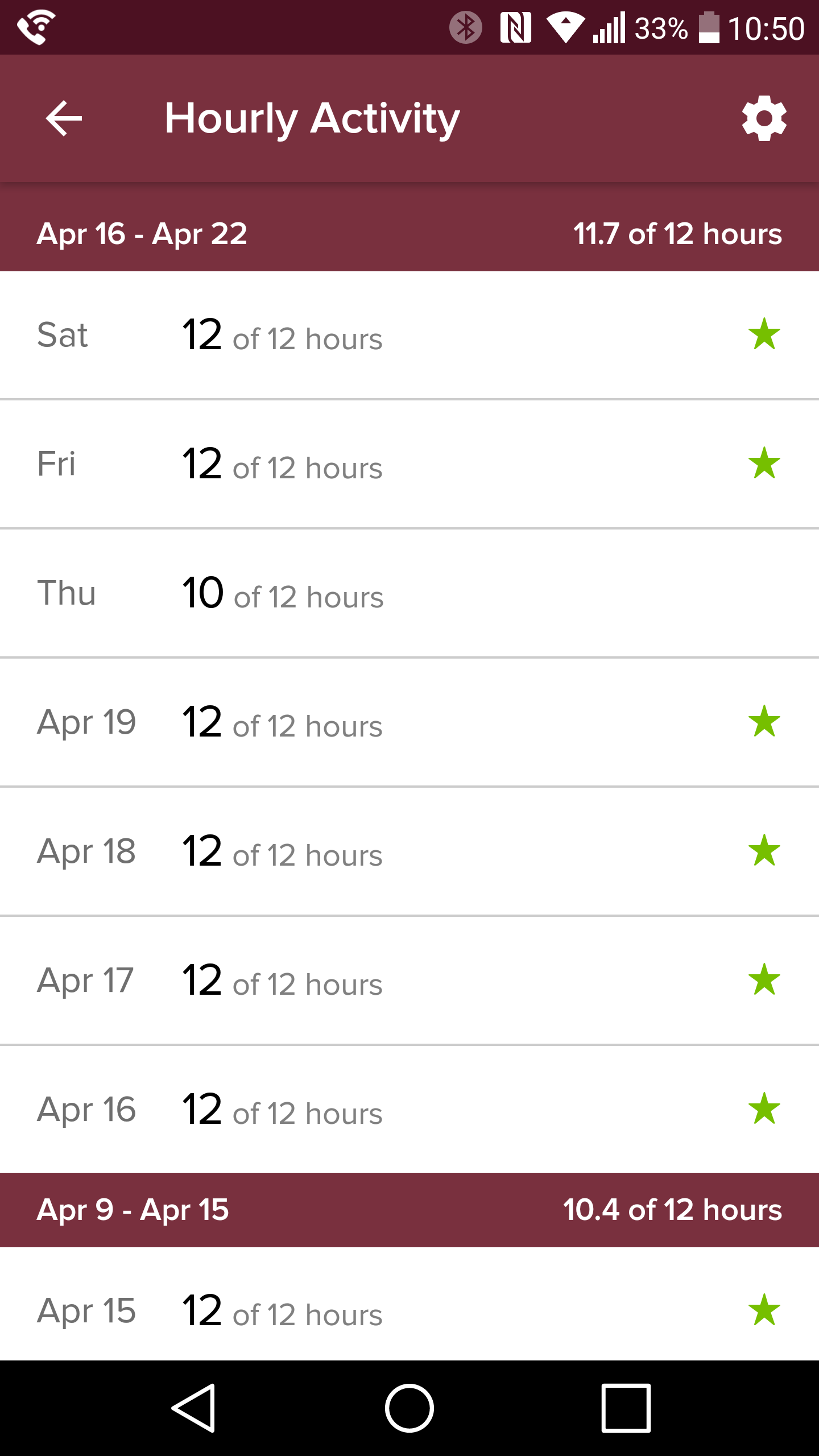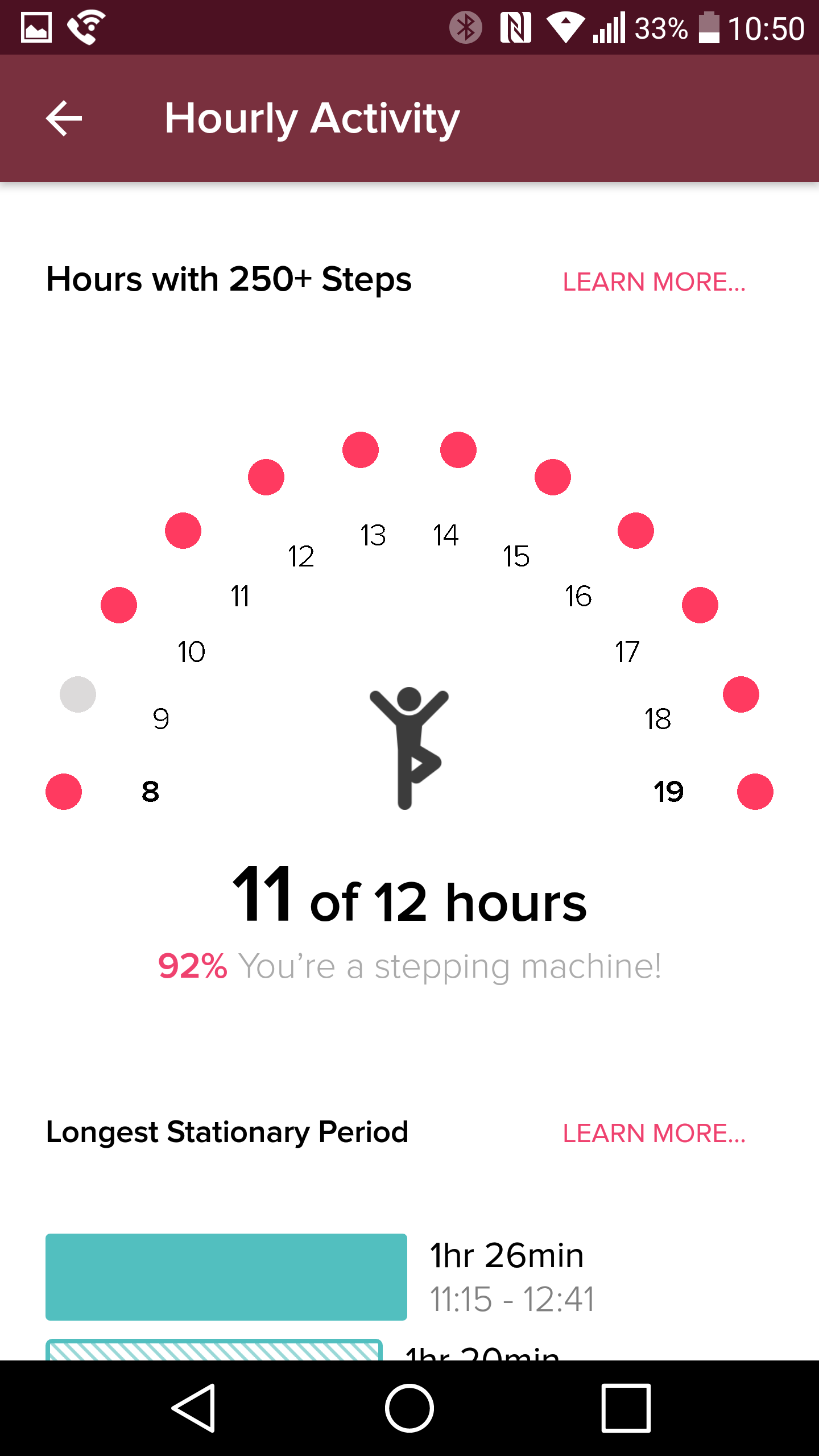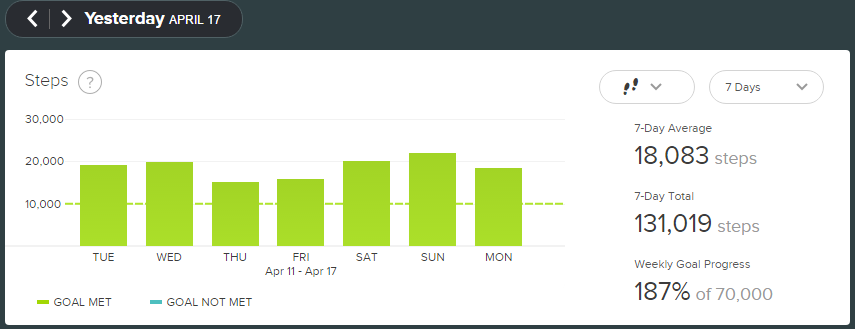Fitbit has a feature that tells you if you've taken at least 250 steps per hour. You can set the start and end times—mine are 8am and 8pm—but you can't turn off the feature entirely.
This feature is driving me batty.
Most days I'm pretty vigilant. Take last week, for example. I got my 12-hour goal almost every day:

Those two hours last Thursday when I missed the goal bother me. But not as much as the 9am hour yesterday, repeated again today, during which I was engrossed in work, made a mental note at 9:45 that I needed to walk Parker, and looked up again at 10:02:

So. Frustrating.
Also notice that it keeps track of your longest time without taking any steps. Again, it's sometimes hard to get up and move because it breaks the flow of coding. All I need to do is just stand up and walk around the room every n minutes to bring the average down, and yet, it's really hard to remember to do that.
Meanwhile, I've hit my larger goal of hitting 10,000 steps per day on 28 of the last 30, and my 30-day moving average is over 15,000 right now. So I'm doing something right.
The Atlantic has a collection of portraits of the Earth-Luna system you simply have to see.
On Friday, President Trump sat down with AP reporter Julie Pace, and...well...here's the transcript, annotated by WaPo.
I suppose I have to read it, but even in the first few moments, I'm struggling.
The Mauna Loa Observatory in Hawaii announced this week that the atmosphere passed 410 ppm of carbon dioxide and is heading for a monthly average of 407 ppm, the highest values observed on earth in millions of years:
Carbon dioxide concentrations have skyrocketed over the past two yearsdue to in part to natural factors like El Niño causing more of it to end up in the atmosphere. But it’s mostly driven by the record amounts of carbon dioxide humans are creating by burning fossil fuels.
“The rate of increase will go down when emissions decrease,” Pieter Tans, an atmospheric scientist at the National Oceanic and Atmospheric Administration, said. “But carbon dioxide will still be going up, albeit more slowly. Only when emissions are cut in half will atmospheric carbon dioxide level off initially.”
Even when concentrations of carbon dioxide level off, the impacts of climate change will extend centuries into the future. The planet has already warmed 1.8°F (1°C), including a run of 627 months in a row of above-normal heat. Sea levels have risen about a foot and oceans have acidified. Extreme heat has become more common.
Too bad all that data isn't persuasive enough for some people. I guess the planet just needs better P.R.
A little busy today, so I'm putting these down for later consumption:
Now, I must prepare...for Whisky Fest!
Cracked did a great video last November that everyone who hasn't paid attention to U.S. defense spending needs to watch:
But hey, without the largest military in the world (times ten), we can't be New Rome, can we?
I especially liked his comparison of the JSF to Star Wars. Just watch.
A combination of really nice weather, a shift in my project at work, and a loyal dog (who is now loyally pooped) has let me get some serious Fitbit steps recently:

That 7-day total is my best since I got a Fitbit in October 2014. The previous record was 129,249 set on June 16th last year—the day I walked 40,748 steps over 35.6 km.
Also on June 16th I set a 30-day total step count record of 507,849, which I'm unlikely to beat soon. As of yesterday, my current 30-day count is 435,763, so I've got a lot of steps to get to hit 508,000.
That said, today's steps might set a new 7-day record. I just need 19,300 for the day to do so. We'll see.
The United Airlines debacle at O'Hare last week underscored how much people really hate airlines:
The severity of the situation really dawned on me last Thursday as I sat in an interview with a local Fox reporter. We started talking about the Chicago Aviation Police, and that’s when it hit me. Over the last few years, police violence has been a hot-button issue. It has spawned the Black Lives Matter movement, and it has polarized people around the country. And here was a textbook example of what people have been rallying against… a defenseless, older minority was dragged off an airplane by the police, and he was severely injured (though not killed, fortunately) in the process. You would have thought this would have ignited another round of vitriol aimed at the police, but no. Everyone blamed United. The Chicago Aviation Police even suspended officers over this, but nobody seems to care. It’s all about United, and that really says a great deal about just how much people hate airlines.
And unfortunately, there is no quick fix:
Can they do that? Well they’re trying. Flush with reasonable profits instead of the razor-thin margins (often negative) they’ve lived off of for years, airlines in the US are investing in their products. It’s now fairly normal to get free video content and free snacks when those were far from the norm just a couple years ago. And this stability also makes it a better work environment for employees. That should result in better service.
But while airlines have started to improve, they’ve also introduced product changes people instantly dislike, including Basic Economy and the decision to add more seats to airplanes. There may be rational justification for these moves, but they don’t play well publicly. Two steps forward, one step back. Or maybe it’s one step forward and two steps back. Either way, any improvement is met by the public with skepticism as people wait for the next axe to fall.
I wonder if people faced similar problems booking passage on sailing ships 200 years ago?
On 13 April 1992, a hole opened under the Kinzie Street Bridge and drowned Chicago's Loop:
During the Great Chicago Flood of 1992, 250,000 gallons of water had the city drowning by the hour.
The leak that sprung in the old freight tunnels under the city quickly turned into a major flood often referred to as the "unseen catastrophe.”
It was a calamity that filled the basements of buildings on State Street, LaSalle Street and even the Merchandise Mart. Water rose to 7 feet, then 10 feet and up. It cut power and evacuated trading floors at the Board of Trade and the Mercantile Exchange. It closed major retails stores like Marshall Fields and even left the Merchandise Mart wet and flooded.
Water poured in from the bottom up. But where was it coming from?
Back in September of 1991, wood pilings were driven into the Chicago River to act as bumpers for the Kinzie bridge house so passing boats wouldn't knock it over. Story has it, the contractor hired to install the pilings hit an underground freight tunnel in the process creating a slow leak that got bigger and bigger with time until the tunnel gave way seven months later: April 13th, 1992.
Historian J.R. Schmidt has more:
It was an odd disaster. At street level, everything looked as it always had. Officials assured the public that the situation was under control. Governor Jim Edgar met with Mayor Richard M. Daley at City Hall. Afterward the governor told reporters there was no need to call out the National Guard.
About 11 a.m. the river locks were opened. That let the Chicago River resume its natural course into Lake Michigan. The water in the tunnels continued to rise, but more slowly.
By evening the water level had finally stabilized. Now the cleaning up and pumping out began. It would take weeks. A private contractor finally had to be brought in to seal the original leak at Kinzie Street.
The water emergency was expensive. Some estimates place the price tag for damaged goods, repair costs, and lost business at over $100,000,000. For insurance reasons, the event is officially classified as a “leak.” But no matter what name is used, those who experienced it firsthand often echo the reaction of their mayor—“What a day!”
Public transit services shined that day, evacuating about a million people from downtown in only a few hours with no injuries or crime.
When you have someone with the background, education, and beliefs of Education Secretary Betsy DeVos, you know you're not going to get any policies that benefit education. Sure enough, yesterday she started rolling back reforms begun under the Obama administration that tried to correct the abuses of the student loan industry:
The former president's administration issued a pair of memorandums last year requiring that the government's Federal Student Aid office, which services $1.1 trillion in government-owned student loans, do more to help borrowers manage, or even discharge, their debt.
But in a memorandum to the department's student aid office, DeVos formally withdrew the two Obama memos. The Obama administration's approach, DeVos said, was inconsistent and full of shortcomings. She didn't detail how the moves fell short, and her spokesmen, Jim Bradshaw and Matthew Frendewey, didn't immediately respond to a request for comment.
DeVos' move "will certainly increase the likelihood of default," said David Bergeron, a senior fellow at the Center for American Progress, a Washington think tank with close ties to Democrats, who previously worked under Democratic and Republican administrations during his more than 30 years at the Education Department before retiring as the head of postsecondary education.
It's an absolute scandal that student loans, which are some of the safest investments a bank can make because they can't be discharged in bankruptcy, have high interest rates and a history of predatory collection practices. DeVos has investments in the for-profit education companies that benefit directly from this situation. And people wonder why the Republican Party has a reputation for screwing the disadvantaged in favor of rich businesses.